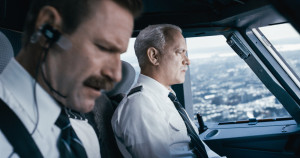I’m confused. If you’re going to delve into the world of revisionist history, shouldn’t you actually come to a different conclusion – that’s why you take on the process, isn’t it? To me, Sully feels like those select post-JFK researchers who studied the Warren Report fact-by-disputed-fact and came to the conclusion that Lee Harvey Oswald acted alone. If you came to that opinion honestly, well, more power to ya, but it’s still neither news, nor entertainment. I’ve already heard that theory and you’re not shining anything new on it.
In Clint Eastwood‘s absurdly defensive biopic Sully, Tom Hanks endures the trials of modern day hero Chesley “Sully” Sullenberger, the airline pilot of US Airways flight 1549 who on January 15, 2009 hit a flock of geese shortly after takeoff from LaGuardia, lost both engines and –out of desperation- landed his craft successfully on the Hudson River, saving the lives of himself and every other person aboard the plane. The oft humble and deflecting Hanks is perfect for the role of oft humble and deflecting Captain Sullenberger and it shows; I don’t there is a better actor out there for this role.
Generating a villain for this film must have been quite an issue. We could blame Angry Birds or in director Clint’s case, an empty chair, I suppose, but that just doesn’t seem right. Not wanting to go with “nature,” like any standard disaster movie would, screenwriter Todd Komarnicki and director Clint Eastwood identified the meticulous, emotionally-challenged, secretive, and bureaucratic US Airways internal investigation team as the boogeymen in a short-lived witch hunt to bring Sully down. I guess if you’ve spoken at an RNC this century, you know all about witch hunts, doncha?
Sully is shown almost entirely out-of-sequence, beginning with an after-the-fact nightmare crash scenario which shocks Captain Sullenberger awake. (Was Sully shot in the same sequence as it was shown?) Editing is crucial in a film like this – we know what happened, so you gotta keep us a awake and interested before you recreate what we all want to see and then you have to figure out how to keep us going when you know the rest is anti-climactic. Eastwood avoids a huge post-Hudson letdown by centering the controversy not in how the events of the day unfolded -that’s just window-dressing- instead Eastwood focuses on the possible guilt of Sully – were his actions reckless or wise? Were they the product of heroism or panic? Why do the computer simulations suggest a return to LaGuardia was possible? Why would a pilot capable of returning to an airport deliberately touchdown on a river? Taken in a different light, the simulations showing how Sully “should have” reacted are an absolute riot. [Complete deadpan] “Birds.” (pause ½ second) “Both engines gone. We are heading back to LaGuardia.” [/deadpan] I have no problem imagining Eastwood directing this scene as an order to display no emotion whatsoever. “No! No! More robotic! Pretend you’re an automaton. This is the crux to showing the evils of progressive behavior.”
Several times the film hints at the danger of a water landing. In fact, the film flat out says, essentially, that water landing = casualties. Why? Why does a water landing necessarily mean fatalities? I really wanted to know that one. Gimme some context here – is it circumstance? Does that mean something has gone so wrong that the plane is already doomed? Is it the inability of rescue crews to attend because of inaccessibility? Does a waterlogged plane sink fast? Was their proximity to NYC both their doom (for lack of possible landing strips) and their saving grace (for the immense number of potential rescue vehicles and people available)?
Personally, I had forgotten “Sully” was short for “Sullenberger.” It’s about as common a nickname as you’ll get  in places like New York and Massachusetts. Far as I can tell, every kid in the Northeast with the last name of “Sullivan” eventually is called, “Sully” at some point in his life. This must get very confusing at family reunions. Of course, if my name were “Chesley,” I might go by “Sully,” as well.
in places like New York and Massachusetts. Far as I can tell, every kid in the Northeast with the last name of “Sullivan” eventually is called, “Sully” at some point in his life. This must get very confusing at family reunions. Of course, if my name were “Chesley,” I might go by “Sully,” as well.
So, ummmm, Clint Eastwood. Fella, buddy, icon, legend … whom exactly are you calling out with this attack on procedure? I think Chesley Sullenberger is a hero. So do most, if not all, people I know. There’s been a little tongue-in-cheek regarding the avoided tragedy, like on “30 Rock,” but the only person I’ve seen who ever really wanted to sully the name of “Sully” is you, Philo Beddoe. And all for what? So you can call out progressives for being heartless … do you really think people who write computer simulations lack emotion, instinct … ? Do you really think there isn’t value to progress made by technology …? Just like the thesis in your baseball tragedy Trouble with the Curve — Sully generates the same underlying notion: with reliance on modern technology, we’ve lost the ability to judge with our senses, and the latter are infinitely more important than the former. Ok, great thesis. Problem is it’s 100% horseshit. And if you want me to believe otherwise, you’re gonna have to start by convincing me that no CGI was used in Sully, i.e. the Hudson landing and nightmare crash sequences were full recreations, not computer gimmickry. How else are we sure that the human element hasn’t been lost in the screenplay?
♪I might know why we’re not soaring true
Pretty soon this will be one big canoe
Take that life vest, prepare to crash
Like a cocktail, just wait for the splash
I want to know … is that Jersey?
I say, “no way!”
Fly me to the river, touch down on the water
Rather have the river, chance it in the water
Running aground, chaos abound♫
Rated PG-13, 96 Minutes
D: Clint Eastwood
W: Todd Komarnicki
Genre: Revisiting undisputed history
Type of person most likely to enjoy this film: Americans
Type of person least likely to enjoy this film: The vociferous ”anti-Sully” lobby
♪ Parody inspired by “Take Me to the River”



